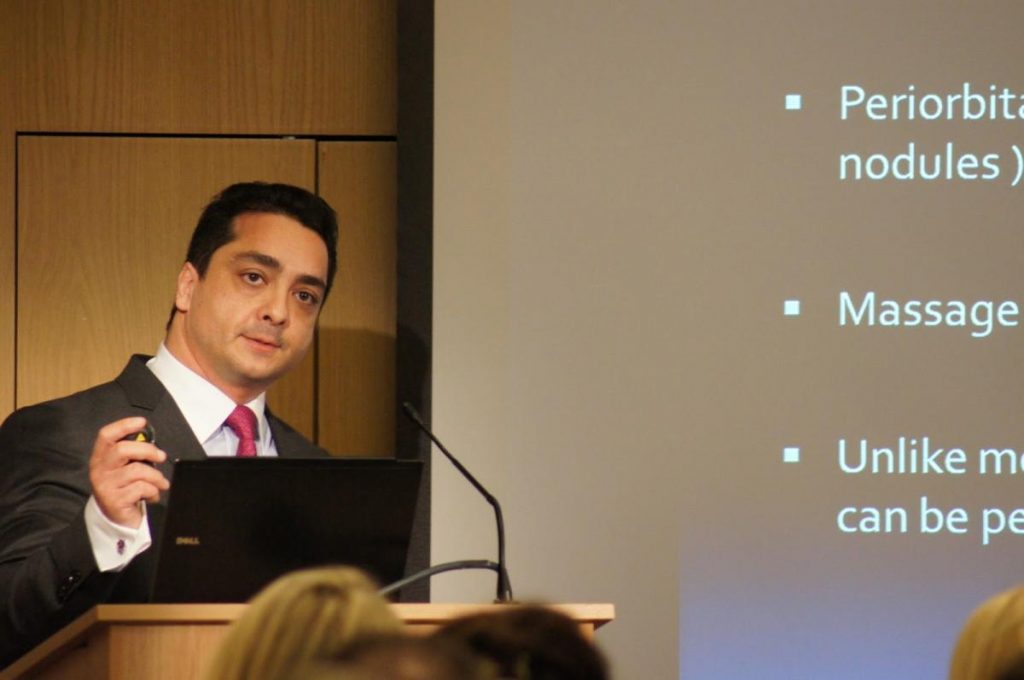Dr Ayham Al-Ayoubi performs many procedures using dermal fillers at the London Medical and Aesthetic Clinic at 1 Harley Street and says that his clients are very enthusiastic about the anti-aging and plumping effects of the treatment and love their fresher appearance.
However, Dr Ayham Al-Ayoubi notes that when his clients come for a consultation, they are often confused by the sheer number of fillers on the market and the way in which they work, saying ‘I always explain the science behind the treatment very thoroughly to my patients, and ensure that they are aware of the different options available to them, as here at the London Medical and Aesthetic Clinic we think that it is essential that patients thoroughly understand their treatment.’

Dr Ayham Al-Ayoubi explains that the physical properties of each of the 100 fillers on the market is different, saying that one of the key differences is the concentration of HA (hyaluronic acid, a protein which is found naturally in the body, important for the hydration and elastic strength of cartilage, which depletes as we age).
Another difference between different fillers on the market is the degree of cross linking in the product, as this will produce different characteristics, resulting in a softer or harder gel.
An uncrossed-linked product will be tolerated by the skin and no reaction will be caused, however, it will give no lifting capacity, so there needs to be a balance to give the filler the physical properties that we need.’
Dr Ayham Al-Ayoubi continues ‘The more cross-linking there is in a product, the more inflammation it will cause, this is why it is so important for manufacturers to balance the concentration and cross-linking for the optimum effect. We must cross link HAs, because otherwise they will give no lift, the two groups most commonly used are carboxylic acid and hydroxyl with alcohol, these cross-links will try to improve the bio-chemical properties, whilst ensuring that it is still compatible with the body.’
Dr Ayham Al-Ayoubi notes that ‘only cross-linked HAs will resist degradation in the body. The more cross linked a product is the closer it is to a solid, therefore the gel is harder, which in turn, makes it more difficult to manipulate, however, it will be more resistant to higher forces. Harder gels are ideal for injecting into deeper places or naso-labial folds when a lot of movement is desired. If the product is less cross- linked it is closer to a liquid and will dissolve more in the tissue and spread more easily, these gels are used for more static and superficial wrinkles, or for enhancing the lips.’
At the London Medical and Aesthetic Clinic at 1 Harley Street, we always want to ensure that our patients experience the least discomfort possible, and Dr Ayham Al –Ayoubi explains that this is why the particle sizing in the gel is extremely important. ‘Particles must be small enough to flow through very small needles, the particle sizes also need to be even, otherwise we will not have a continuous flow through the needle, which can be painful for the patient.’

Dr Ayham Al-Ayoubi gives some interesting facts about the history of dermal fillers:
As early as the 1890s fat was extracted from patients’ bodies and injected into their faces to plump up the skin and create a more youthful look. In the early 1900s physicians began to use paraffin instead of the patient’s own fat, however a high incidence of foreign body granuloma was discovered.
In the 1940s a highly refined injectable silicone was used as a dermal implant with excellent cosmetic results. However, this injectable silicone had problematic side effects from contaminated composites and it has now been banned.
In the wake of the AIDs epidemic and a concern for blood borne diseases, it was quickly taken off the market. It was replaced with autologous collagen processed from harvested fat and injectable water based polyacrylamide gel was launched. In 1996, an FDA appproved hyaluronic acid obtained by a filtering process was launched. Despite being animal derived, it does not require a skin test and lasts 4 – 5 months before being naturally re-absorbed by the body.
In 1998, Dermal Fillers came onto the market, Dermal Fillers are still very popular today, and many procedures are performed in our London Medical and Aesthetic Clinic at 1 Harley Street. 1999 was a very exciting year for dermal fillers, as it was the year that Collagen Stimulation was introduced to the market. Collagen Stimulation is still considered to be an extremely advanced product, and skilled Collagen Stimulation surgeons are able to achieve a non-surgical facelift using this Collagen Stimulation.
To read more about Dermal Fillers click here





